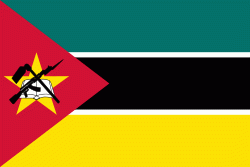Island of Mozambique (Mozambique Island)
The Island of Mozambique (Ilha de Moçambique) lies off northern Mozambique, between the Mozambique Channel and Mossuril Bay, and is part of Nampula Province. Prior to 1898, it was the capital of colonial Portuguese East Africa. With its rich history and sandy beaches, the Island of Mozambique is a UNESCO World Heritage site and one of Mozambique's fastest-growing tourist destinations. It has a permanent population of approximately 14,000 people and is served by nearby Lumbo Airport on the Nampula mainland. The name of the country, Mozambique, is derived from the name of this island.
Pottery found on Mozambique Island indicates that the town was founded no later than the fourteenth century. According to tradition, the original Swahili population came from Kilwa. The town's rulers had links with the rulers of both Angoche and Quelimane by the fifteenth century. In 1514, Duarte Barbosa noted that the town had a Muslim population and that they spoke the same Swahili dialect as Angoche.
The name of the island (Moçambique, pronounced ) is derived from Ali Musa Mbiki (Mussa Bin Bique), sultan of the island in the times of Vasco da Gama. This name was subsequently taken to the mainland country which is modern-day Mozambique, and the island was renamed Ilha de Moçambique (Island of Mozambique). The Portuguese established a port and naval base in 1507 and built the Chapel of Nossa Senhora de Baluarte in 1522, now considered the oldest European building in the Southern Hemisphere.
During the 16th century, the Fort São Sebastião was built, and the Portuguese settlement (now known as Stone Town) became the capital of Portuguese East Africa. The island also became an important missionary centre. It withstood Dutch attacks in 1607 and 1608 and remained a major post for the Portuguese on their trips to India. It saw the trading of slaves, spices, and gold.
Apart from the ancient fortifications, only half of the town is stone-built. The hospital, a majestic neo-classical building constructed in 1877 by the Portuguese, with a garden decorated with ponds and fountains, was repainted white after the Mozambican Civil War. For many years, it was the biggest hospital south of the Sahara.
With the opening of the Suez Canal, the island's fortunes waned. In 1898, the capital was moved to Lourenço Marques (now Maputo) on the mainland. By the middle of the 20th century, the new harbour of Nacala took most of the remaining business.
Pottery found on Mozambique Island indicates that the town was founded no later than the fourteenth century. According to tradition, the original Swahili population came from Kilwa. The town's rulers had links with the rulers of both Angoche and Quelimane by the fifteenth century. In 1514, Duarte Barbosa noted that the town had a Muslim population and that they spoke the same Swahili dialect as Angoche.
The name of the island (Moçambique, pronounced ) is derived from Ali Musa Mbiki (Mussa Bin Bique), sultan of the island in the times of Vasco da Gama. This name was subsequently taken to the mainland country which is modern-day Mozambique, and the island was renamed Ilha de Moçambique (Island of Mozambique). The Portuguese established a port and naval base in 1507 and built the Chapel of Nossa Senhora de Baluarte in 1522, now considered the oldest European building in the Southern Hemisphere.
During the 16th century, the Fort São Sebastião was built, and the Portuguese settlement (now known as Stone Town) became the capital of Portuguese East Africa. The island also became an important missionary centre. It withstood Dutch attacks in 1607 and 1608 and remained a major post for the Portuguese on their trips to India. It saw the trading of slaves, spices, and gold.
Apart from the ancient fortifications, only half of the town is stone-built. The hospital, a majestic neo-classical building constructed in 1877 by the Portuguese, with a garden decorated with ponds and fountains, was repainted white after the Mozambican Civil War. For many years, it was the biggest hospital south of the Sahara.
With the opening of the Suez Canal, the island's fortunes waned. In 1898, the capital was moved to Lourenço Marques (now Maputo) on the mainland. By the middle of the 20th century, the new harbour of Nacala took most of the remaining business.
Map - Island of Mozambique (Mozambique Island)
Map
Country - Mozambique
 |
 |
| Flag of Mozambique | |
Notably Northern Mozambique lies within the monsoon trade winds of the Indian Ocean and is frequentely affected by disruptive weather. Between the 7th and 11th centuries, a series of Swahili port towns developed on that area, which contributed to the development of a distinct Swahili culture and dialect. In the late medieval period, these towns were frequented by traders from Somalia, Ethiopia, Egypt, Arabia, Persia, and India.
Currency / Language
| ISO | Currency | Symbol | Significant figures |
|---|---|---|---|
| MZN | Mozambican metical | MT | 2 |
| ISO | Language |
|---|---|
| PT | Portuguese language |















